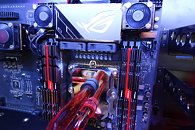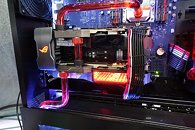Wednesday, June 6th 2018

ASUS ROG Dominus Pictured, Core i9 XCC Confirmed to Feature 6-channel Memory
This Tuesday at its Computex presser, Intel unveiled an unnamed 28-core/56-thread HEDT (client-segment) processor that's capable of being bench-stable at 5.00 GHz. The chip is a client-segment implementation of the Skylake XCC (extreme core count) silicon, which features 30 Mesh Interconnect "tiles," of which 28 are cores and two integrated memory controllers. The XCC silicon features a 384-bit wide (6-channel) DDR4 memory interface, and it turns out that whatever SKU Intel is planning, will require a different motherboard from your X299 board that can handle up to 18 cores and 4-channel memory. It will require a client-segment variant of the LGA3647 enterprise socket from the Purley platform. One of the first of these is the ASUS Republic of Gamers (ROG) Dominus.
Clearly bigger than ATX, in being either E-ATX or SSI form-factor, this board draws power from two 24-pin ATX, two 8-pin EPS, and three 6-pin PCIe, and has a gargantuan 16-phase VRM with two fan-heatsink blocks. Six DDR4 DIMM slots flank the socket, three on either side, each with its dedicated 64-bit wide path to the socket. The XCC silicon features a 48-lane PCI-Express gen 3.0 root complex, and so the board could feature at least two PCI-Express 3.0 x16 capable of full bandwidth, among a boat load of PCIe based storage connectivity, and onboard devices.Update: This motherboard may have been a quick modification of the WS C621E SAGE, by removing one of its sockets, and modifying the rest of the board accordingly. Prototyping a board like that, for a company with ASUS' resources, would barely take 2-3 weeks by our estimate.
Clearly bigger than ATX, in being either E-ATX or SSI form-factor, this board draws power from two 24-pin ATX, two 8-pin EPS, and three 6-pin PCIe, and has a gargantuan 16-phase VRM with two fan-heatsink blocks. Six DDR4 DIMM slots flank the socket, three on either side, each with its dedicated 64-bit wide path to the socket. The XCC silicon features a 48-lane PCI-Express gen 3.0 root complex, and so the board could feature at least two PCI-Express 3.0 x16 capable of full bandwidth, among a boat load of PCIe based storage connectivity, and onboard devices.Update: This motherboard may have been a quick modification of the WS C621E SAGE, by removing one of its sockets, and modifying the rest of the board accordingly. Prototyping a board like that, for a company with ASUS' resources, would barely take 2-3 weeks by our estimate.





35 Comments on ASUS ROG Dominus Pictured, Core i9 XCC Confirmed to Feature 6-channel Memory
But they coud'nt actually do any demonstration since the power at that place was not sufficient to run both chiller & system, LOL.
Just like Z370 was rushed to get 6-cores into the mainstream to compete with AMD's 8 (leaving what is now called Z390 (which was originally supposed to be Z370 and launched half a year later) as some weird in-between unloved stepchild), this seems like Intel realized a couple of months ago that they were probably going to compete with 32-core Threadrippers later this year, so they took a server platform, made the bare minimum of changes to it required to call it a consumer platform, and pushed it out.
At least AMD was forward-thinking enough to use their server socket on X399, leaving them room to grow. They also have an "advantage" in not needing the gigantic VRM required to OC these chips, of course. OC'd TR might max out at 300-ish W (though likely somewhat higher for TR2) , while these likely run 700-1000W at max clocks depending on chip quality. As such, X399 can have more sensible motherboard designs. Not that the same isn't possible for this platform, but people will probably whine when they can't OC their $2-4000 CPU on their $1000 motherboards.
The 5GHz Cinebench from Intel is kinda spoiling the fun though
As for the viability, the power bill and power draw isn't an issue for anyone who can actually want/need the compute power (and can afford it). The issue is sub-ambient cooling, which isn't viable over any kind of time in pretty much any situation (unless you're running it in a hermetically sealed case stuffed with silica gel packets or some such zero-humidity environment).